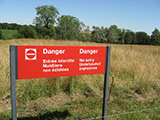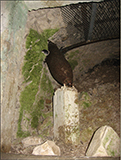-Legacies of the Great War
-WWI Munitions Still Live Beneath Western Front
-Lethal relics from WW1 are still emerging
04/05/2014
When World War One ended with an armistice on November 11, 1918 it was the most devastating and largest war the world had ever experienced. Millions of soldiers from around the world were engaged in the horrific, lice-ridden quagmire of trench warfare. Magnifying the destructiveness was the somewhat new industrialization of warfare or the mass production of weapons... weapons that were more deadly and accurate than ever before.
Despite the advancements in designing and constructing armaments, World War One was also notorious for its poorly and hastily built bombs. For example, at the Battle of the Somme (July - November, 1916) the Allies fired nearly two million artillery shells in the week preceding the battle. Out of these two million shells, as much as 70% of them were duds or unexploded ordinance. To be fair, the muddy terrain of the Western Front made it difficult for the bombs to "feel" the impact resistance they needed in order to detonate. The mud simply allowed the bombs to sink deep into the earth. Still, many of the bombs were quickly and poorly constructed in their factories contributing to their ineffectiveness in the field. It is estimated that over 1.5 billion artillery shells were fired during the four year war making it impossible to know the exact number of deadly bombs still buried along the Western Front.
Today, If you take a tour of a battlefield on the Western Front you will find that barbed wire and warning signs still prohibit access to many parts of “no man’s land.” The restriction is not in place due to the looming threat of machine gun fire, but something just as deadly. Each year in France, thousands of tons of unexploded and very live artillery shells are excavated from the Western Front. This removal process is commonly known as "the iron harvest." Because of the danger, battlefield visitors are not allowed to freely roam out of the trenches and into “no man’s land.”
Almost a century later, poisonous gases are also alive and well in their shells and capable of harming those who detonate them. Persons in charge of excavations not only equip themselves with shovel and gloves, but also carry gas masks. The threat of mustard gas burning lungs and skin remains all too real.
Each year a handful of people across France and Belgium are killed when shells thought to be harmless are tampered with or simply unseen and struck in some way. Just this past March, two construction workers were killed in Belgium when an unseen grenade exploded while they were working nearby. Each year excavators remove approximately 75,000 tons of unexploded shells across the Western Front. In 2013, 160 tons of shells, bullets, etc. were removed from the areas around Ypres, Belgium alone.
As we approach the centennial of the Great War, one must wonder if the scientists, engineers, and military commanders ever thought their destructive bombs would still be ending lives a century later.
-WD




